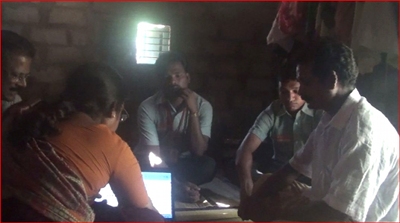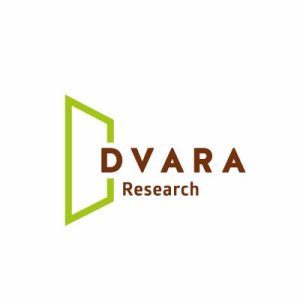Last month the Wealth-Management Cross-Functional team had visited 15 households in Thanjavur to pilot the Wealth Management process. A week ago we revisited some of these households with a draft of the Financial Wellbeing Report to see how we could engage in a constructive dialogue with the household on various aspects of their financial lives. One such family was that of Jaya (name changed), a customer enrolled at Andipatti branch of Pudhuaaru KGFS.
The Family – Jaya (40) and her husband Rajan (42) live in a thatched house in Karukkadipatti village. The couple has three children Neetha (16), Vinodini (18) and Pramod (20). While the daughters Neetha (1st Year BSc) and Vinodini (10th Std) are still studying, the eldest son Pramod has just started working in Qatar as a driver. The daughters stay at Jaya’s sister’s house in a nearby village.
 Their Activities – Till about 5 years back, Rajan worked in a hotel in Singapore. When he returned, he decided to manage the tea shop business that his father used to run. Rajan manages to make about Rs.1,20,000 a year from the shop. Apart from this the family owns about 1.3 acres of agricultural land and manages a net income of about Rs.35,000 by growing paddy for two seasons and black gram for one. The two cows they have fetch them a net income of Rs.4,000 a year. The family spends about Rs.39,000 a year on routine household expenses. Picture: Rajan (right) interacting with the team.
Their Activities – Till about 5 years back, Rajan worked in a hotel in Singapore. When he returned, he decided to manage the tea shop business that his father used to run. Rajan manages to make about Rs.1,20,000 a year from the shop. Apart from this the family owns about 1.3 acres of agricultural land and manages a net income of about Rs.35,000 by growing paddy for two seasons and black gram for one. The two cows they have fetch them a net income of Rs.4,000 a year. The family spends about Rs.39,000 a year on routine household expenses. Picture: Rajan (right) interacting with the team.
Goals – Among the list of goals that the household wishes to fulfil, Neetha and Vinodini’s education over the next five years alone will cost the family Rs. 3.6 lakhs (1 lakh = 1,00,000). Other priorities include their marriage (Rs. 5 lakhs each) and expansion of the shop (Rs 20,000).
With this and other information about the household, we set about preparing a Financial Wellbeing Report for them. The report talks about four pathways (Plan-Grow-Protect-Diversify) towards financial wellbeing – all of which try to answer the central question for the customer “How can Wealth Management help improve my financial wellbeing?”
The Advice – The specific advice around protection includes Life Insurance for Jaya (Rs.50,000), Pramod (Rs.5,00,000), Vinodini (Rs.4,20,000) and Neetha (Rs.3,80,000); Accident Insurance for Jaya (Rs.2,00,000), Rajan (Rs.1,75,000), Pramod, Vinodini & Neetha (Rs.5,50,000 each). Insurance for the cow and shop is also suggested upto their current market values. Life Insurance decisions are linked to human capital (Present Value of Lifetime Income net of Own Expenses) of each member.
As regards the surplus generated by the household, the advice was to allocate it in the following proportion: Index Fund – 20%, Gold – 18% and MMMF – 62%. This advice is consistent with the desired features of high returns, diversification from local assets and diversification in assets uncorrelated with human capital. Jaya should also maintain a separate balance of about Rs. 10,000 in the MMMF account to take care of liquidity needs.
The shop being a high TIP (Total Income Potential) asset, the advice is to borrow for its renovation. For all other medium to long-term goals that are 3 to 8 years away, a combination of savings and borrowing is advised.
For a full explanation of Jaya’s Financial wellbeing report please click here.
We would urge all those reading this to share their comments and suggestions on the process and the recommendations in the comments section below. What are we missing?
—
Shilpa Sathe of InnerWorlds and Amit Shah of Rural Finance (presently known as Dvara KGFS) contributed to this post.



3 Responses
This is a great effort.
1. Please discuss more details on arriving at optimal level of insurance and the utility function
2. How the cash flows are projected in future (What assumptions?)
3. Share the user's experience in more details when they saw this level of financial planning.
4. Would help if the 'Financial Well Being' report is discusses and shared.
Some points on your third query – For the first few minutes, the conversation revolved around the goals his family had and what they would cost. While speaking to him about how much he needed to set aside on a monthly basis, borrowing money from relatives, leasing out land or pledging gold were the few ways in his mind of meeting these expenses.
The previous year had been good for this family with the tea shop and agriculture generating a lakh worth of surplus. The family had used this to renovate the house, to buy gold for Nagarajan’s sister and some amount was spent as funeral expenses on the death of a relative. But this meant that apart from the gold he had, there were no other forms of savings. He was expecting money from his son which he planned to put in a bank (he has never saved with a bank before) or buy some gold. Cheated by his relatives and the post office on a few occasions, he had no savings now. His mother had spent all the money he remitted from Singapore for 10 years on his sisters and hence he had nothing for his own family when he came back. He was determined not to let this happen with his son’s savings.
The concept of insurance was easily understood and he wanted to know more about the products available with KGFS. He asked us if we could tell him about the schemes and the premium he would have to pay. He was happy to find out that his cow could be insured but he did not want to insure an old cow he had. He had plans to sell her, buy a new one and then insure the new cow.
We then proceeded to explain why diversification is important using examples of bad rains affecting the local economy. He promptly understood that by sending his son abroad and investing in gold he was diversifying but we also explained to him that there were several investment avenues available in the market. The MMMF product of KGFS was familiar to him and we took this as an example to explain other innovative products that KGFS would roll out. Since we did not have any ‘optimum investment plan’ charted out for his family we told him to have a conversation with the wealth manager on these products.
Finally, we took his opinion on the usefulness of the time we spent with him and what he thought of the format of the report. The report according to him was simple to understand since he had spent some time abroad and was fairly educated but thought that the graphs might not make complete sense to an average villager. The conversation to him was more important and very relevant. He urged us to give him an investment and savings plan if we could. He thought that if the villagers knew what steps to take after all these conversations it would do them a great service. We have promised him and the other households we visited to incorporate their suggestions in our thinking.